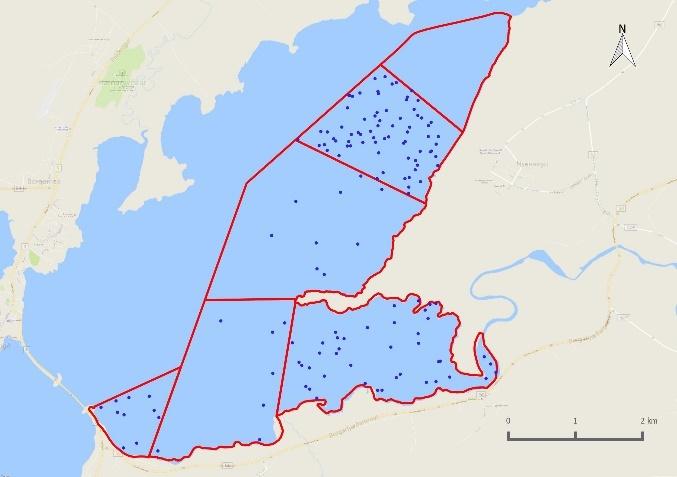
3 minute read
3.2 Subsite usage
3.2 Subsiteusage
Birds’ preferences for particular parts of a site are likely driven by the type of substrate; density or availability prey; shelter from winds or waves; disturbance; distance to high tide roosts; or perceived or actual predation pressure.
Kistufjörđur (Est 2) supported a higher density of birds, during both low tide and rising tide surveys, than the other subsites. Bird density was higher during low tide surveys in Grjóteyrarklakkur (Est 1), Kistufjörđur (Est 2) and Flæðhöfðasker (Est 6) during low tide surveys, compared to rising tide surveys (Figure 3-3). For the other three subsites the density of birds-records was similar during low tide and rising tide surveys. While no benthic sampling was carried out within the study area as part of this study or previously, the birds’ apparent preference for Kistufjörđur (Est 2), Grjóteyrarklakkur (Est 1) and to Flæðhöfðasker (Est 6) during low tides is likely driven by prey availability. These subsites have a higher proportion of muddier substrates than the other subareas and are the least exposed to wind and waves (especially Kistufjörđur (Est 2)). Such conditions typically support high numbers of benthic invertebrates (Little 2000; McLusky & Elliot 2004; Fujii 2012), with sandier sediments supporting comparatively fewer invertebrates (Prater 1981). Furthermore, the Andakílsá river flows into for Kistufjörđur (Est 2). This is a productive river and supports high levels of biodiversity (Ólafsson et al. 2006). The particulate organic carbon values for Andakílsá are among the highest recorded in Iceland, and much of this particulate matter is algae that flows from Lake Skorradalsvatn (c. 10 km inland) (Eiríksdóttir et al. 2010). When this enters the calm waters of the estuary, a large portion of it is deposited onto the estuarine mud, promoting the benthic invertebrate communities that are important for waterbirds. Subareas 3, 4, and 5 are sandier and comprise the outflow of the glacial Hvítá river, which is likely to carry fewer nutrients.
For wildfowl, by far the highest density was recorded in Kistufjörđur (Est 2) (Figure 3-4). The highest density of waders was recorded in Kistufjörđur (Est 2). Relatively high densities of waders were recorded in Grjóteyrarklakkur (Est 1) compared to the other subsites (Figure 3-4). For seabirds, highest densities were recorded in Flæðhöfðasker (Est 6). This is mostly driven by an Arctic Tern colony, which is adjacent to Flæðhöfðasker (Est 6).
11000 10000
records per km 2 Bird
9000 8000 7000 6000 5000 4000 3000 2000 1000 0 Low-tide Rising-tide
Grjóteyrarklakkur Kistufjörđur Kistuhöfðahólmar Ásgarđshöfđi Hvítárleirur Flæðhöfðasker Est 1 Est 2 Est 3 Est 4 Est 5 Est 6 Subsite name and code Figure 3-3. Waterbird and seabird density in each of the six subsites during weekly low tide and rising tide estuarine surveys in the Andakíll Ramsar site between 12th March and 25th October, 2017. See Figure 2-1 for subsite locations and boundaries.

Figure 3-4. Total number of bird-records in six subsites in the estuarine habitat of the Andakíll Ramsar site recorded in weekly low tide and rising tide estuarine surveys between 12th March and 25th October, 2017. See Figure 2-1 for subsite locations and boundaries.
Bird records per km 2
11000 10000 9000 8000 7000 6000 5000 4000 3000 2000 1000 0 Wildfowl and allies Waders Seabirds



Grjóteyrarklakkur Kistufjörđur Kistuhöfðahólmar Ásgarđshöfđi Hvítárleirur Flæðhöfðasker Est 1 Est 2 Est 3 Est 4 Est 5 Est 6 Subsite name and code
Some species or species groups have specific requirements, whereas others have a wider tolerance for different conditions. Those with specific requirements are more likely to be impacted by changes or developments in, or close to, the site. The distribution of each species at subsite level is presented in Table 3-3. This shows that some species were regularly recorded in different subsites, and others showed a preference for a particular subsite (or subsites). For example, Teal and Oystercatcher were recorded disproportionately in Kistufjörđur (Est 2) during low tide and rising tide surveys and Eider showed a preference for Flæðhöfðasker (Est 6) during low tide surveys. Greenland White-fronted Geese were disproportionately recorded in Ásgarđshöfđi (Est 4), and were rarely encountered in other subsites. Fulmars were recorded in Flæðhöfðasker (Est 6), Grjóteyrarklakkur (Est 1) and Kistufjörđur (Est 2) as they commuted between the breeding colony at Brekkufjall (c. 1.5 km south of the survey area) and the open sea, and were not recorded as ‘using’ the site for foraging or roosting.










